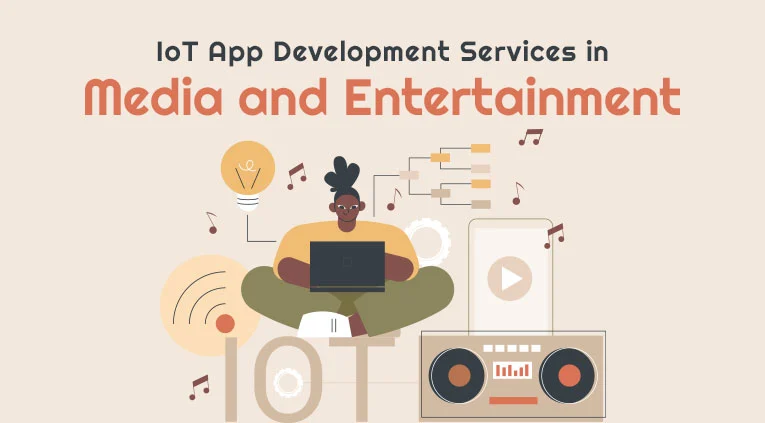The Internet of Things (IoT) is revolutionizing the gaming industry with its growing applications. IoT technologies are enabling gamers to experience immersive and interactive gaming experiences that were never before thought possible.
From virtual reality to augmented reality, this tech advancement has enabled IoT app development companies and players to explore new dimensions in their gaming worlds with unprecedented levels of detail and realism.
With this technology, the future of gaming looks brighter than ever, as it promises to bring a whole new level of engagement and entertainment into our lives. By connecting devices across different platforms, IoT can provide access to real-time data, which can be used by game designers and developers to create more exciting games that will appeal to an even wider audience.
As such, it’s no surprise why so many companies are investing heavily in developing innovative ways of utilizing this powerful technology to stay ahead of the competition. This article will explore how the Internet of Things can be used to enhance gaming experiences. But before that, let’s look at some transforming statistics of IoT in the gaming industry.
Gaming Industry Statistics
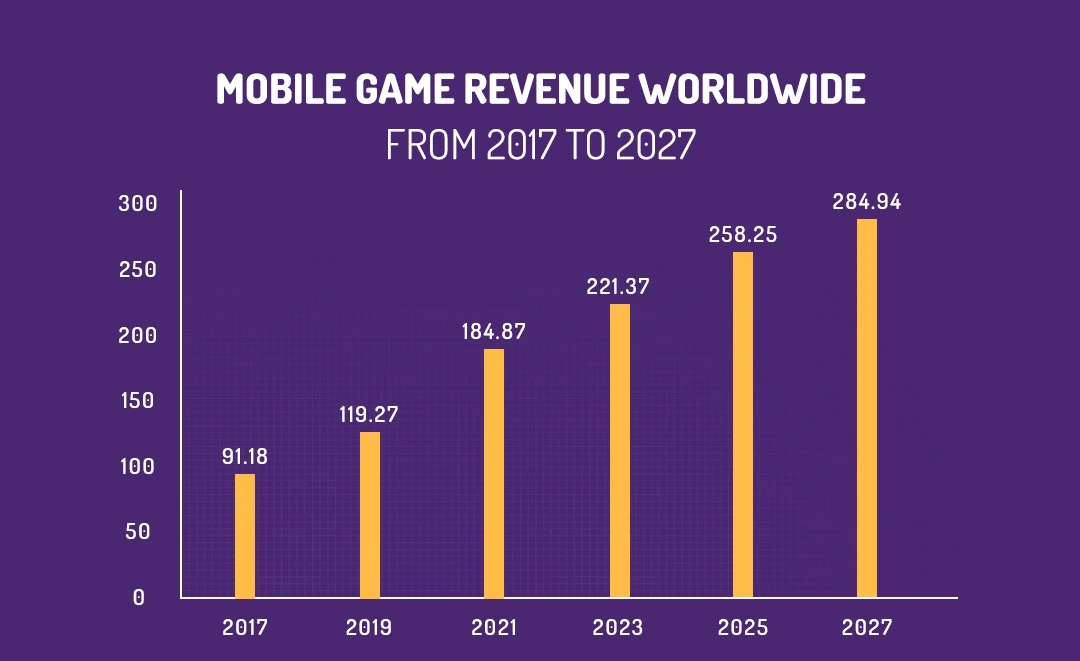
1. According to reports, the global revenue of the gaming industry was around $196.92 billion in 2022, and it’s expected to surge to $285 billion by the end of 2027.
2. The global VR gaming industry is worth around $6.26 billion and it’s expected that this industry will grow with a CAGR of approximately 31.4 between 2021 and 2028.
3. IoT covers a whopping 47% share of the global gaming market, worth over $63 billion.
4. In the era of cloud streaming, IoT is set to play a major role again, allowing developers and publishers to connect players without any specific hardware.
Looking at these statistics, it’s clear that the Internet of Things is proving to be a vital component of the gaming industry. With its growing relevance, let’s explore how IoT technology is impacting the gaming industry and how IoT solutions for game development are getting transformed.
How Exactly Does IoT Advancement Fit in the Gaming Industry?
The Internet of Things is making it possible for gamers to experience immersive and interactive gaming experiences far beyond what was thought possible. Let’s look at some of the features that IoT is bringing to the gaming industry:
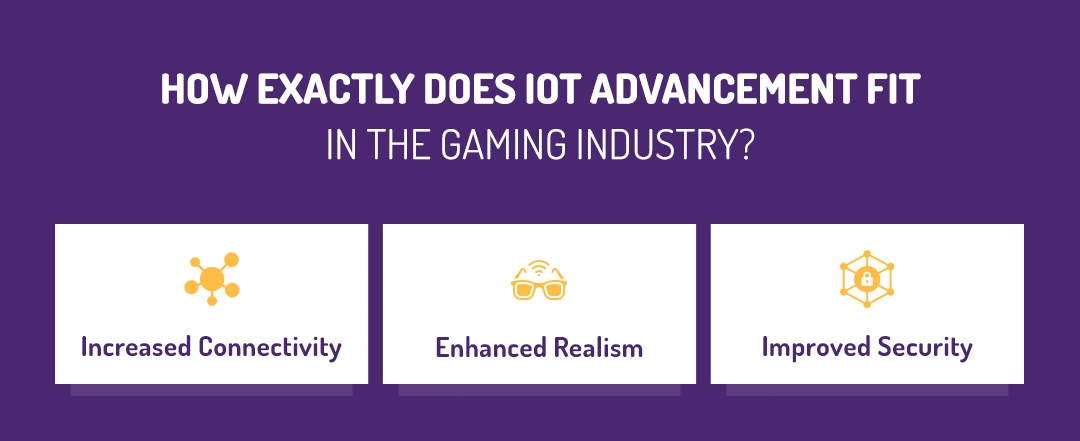
1. Increased Connectivity
IoT has enabled enhanced connectivity between gamers and their gaming devices. This allows gamers to access real-time data from their games and exchange information with each other, allowing for a more engaging and immersive experience.
2. Enhanced Realism
IoT technologies are helping to create more realistic gaming environments that can transport players into a different world. By combining virtual reality, augmented reality, and other immersive technologies, gamers can experience game worlds like never before.
3. Improved Security
IoT can help protect gamers from malicious threats, such as hackers and malware. Through secure platforms based on cloud computing, IoT technologies can provide additional layers of security to protect gamers’ personal information and payment details.
As the gaming industry continues to evolve, IoT technologies will continue to play an important role in the development of games. On this note, let’s explore the robust benefits of IoT in the gaming continuum.
Advantages of IoT in Game Development
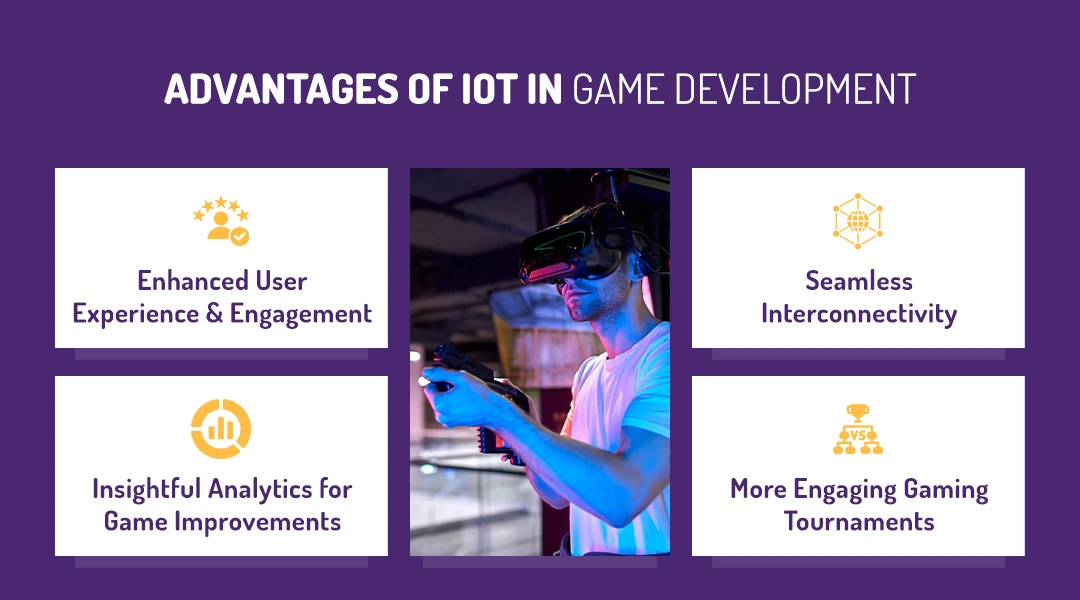
1. Enhanced User Experience and Engagement
Using IoT solutions, developers can create more engaging game experiences for gamers. By integrating real-time data and analytics, games can be made even more interactive and immersive.
In conventional gaming, developers are often unable to capture real-time data which hinders the potential of their games. IoT technologies help in this regard by providing access to real-time data which can be used to improve game mechanics and experiences.
When we look from an end user’s perspective, IoT is a “beyond the fun” experience. IoT-enabled devices help the gameplay be more entertaining, by increasing their interactivity with the game.
For example, IoT-connected motion controllers allow gamers to control the game using gestures and body movements. This feature can be used to change the environment of the game, as well as accurately simulate complex activities such as shooting a gun or driving a car.
2. Seamless Interconnectivity
In gaming, interconnectivity refers to the ability of gamers to play with each other from different devices and locations. IoT-enabled gaming systems can facilitate seamless interconnectivity by providing reliable communication networks that can connect gamers across multiple platforms.
In addition, IoT game development solutions can also enable secure data transmission between gaming devices and servers, which helps protect players’ data and prevents hackers from accessing sensitive information.
Cloud computing is an integral part of IoT and can be extremely beneficial in the gaming industry. Cloud-based technologies can be used for seamless interconnectivity across different devices, as well as for creating virtual game worlds that can be accessed by gamers located in different parts of the world.
When games have higher interconnectivity and a closed-loop system, gamers can be better engaged and feel more connected to the game, resulting in improved user retention.
3. Insightful Analytics for Game Improvements
For a game development company, it’s crucial that they understand the behavior of the gamers and what features can be implemented to make their gaming experience better. IoT analytics tools help developers by providing insights into gamers’ behavior.
The data gathered by IoT analytics can be used to improve game mechanics, optimize server performance, and create an overall better gaming experience. With data-driven decisions, developers can create games that are more engaging, enjoyable, and rewarding for gamers.
When it comes to improving the core game mechanics, data from IoT analytics can be used to identify areas that need improvement. For instance, if the game is too difficult for a certain set of users, developers can adjust the difficulty level accordingly so that they can retain the players.
4. More Engaging Gaming Tournaments
With the help of IoT, developers can create real-time gaming tournaments that are more engaging for gamers. For instance, tournaments can be set up where players from different parts of the world compete against each other in a virtual environment.
These kinds of tournaments provide an enhanced experience for gamers as they get to connect with players from all around the world. Moreover, with real-time analytics, developers can easily identify the best-performing players and reward them accordingly.
In addition to this, IoT technology can be used to create virtual reality (VR) gaming tournaments. VR games are more immersive and engaging than conventional games because gamers feel like they are in the game environment. This enhances the gaming experience and makes it even more enjoyable.

Core Gaming Areas Where IoT Can Thrive and Rise
Both IoT and online gaming are broad and the scope is vast. Integration of both creates several opportunities that can benefit the gaming industry:
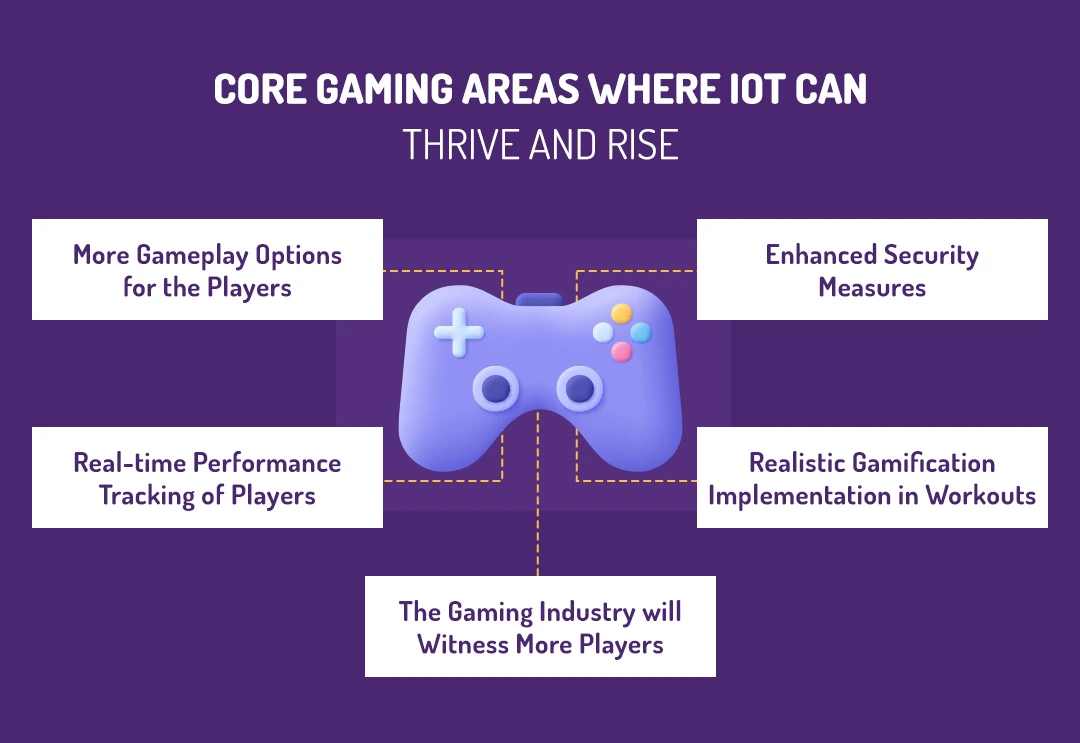
1. More Gameplay Options for the Players
In conventional gaming, players are limited to a certain set of rules and objectives. With IoT-enabled services, developers can create games that have more dynamic objectives and a range of options for players.
For instance, if the game is a shooter game, instead of just shooting targets, players can be given options to explore the environment, talk to characters, and interact with objects. This can create a more engaging experience for players as there will be more possibilities for them to explore.
In addition, IoT-enabled games can also provide players with real-time feedback and tips on how to improve their gaming strategies. This can help players become more competitive in the game and increase their chances of winning.
When players have better and more intuitive gaming options, they will be more likely to stick with the game and become more loyal users. Furthermore, the game will remain fresh for a longer period of time, and gamers won’t get bored.
2. Enhanced Security Measures
The gaming industry is highly vulnerable, especially where real prize money is involved. With the help of IoT, developers can enhance the security measures in their games and protect against potential cyber-attacks.
For instance, two-factor authentication can be implemented to provide an extra layer of protection for users’ accounts. Moreover, with data analytics, anomalies in user activity can easily be identified, and suspicious activities can be blocked.
These security measures will protect not only the players and their money but also the reputation of the game developers. This is important as gamers are more likely to trust developers who can provide them with a secure gaming experience.
It’s also possible to make game development services more transparent by using blockchain technology. This way, gamers can easily keep track of the game development process and have more confidence in the developers.
3. Real-time Performance Tracking of Players
IoT is a boon for professional players as it can provide them with real-time performance analytics. For instance, a professional gamer can track their in-game performance such as reaction time, accuracy, and power-ups.
This way, players can identify areas for improvement and work on them accordingly. Moreover, with IoT-enabled devices, professional gamers can train themselves more effectively to have an edge over their competitors.
This way, players can identify areas for improvement and work on them accordingly. Moreover, with IoT-enabled devices, professional gamers can train themselves more effectively to have an edge over their competitors.
Moreover, this technology can also be used for esports tournaments as players can compare their performance with other gamers from around the world. This will help them hone their skills and become better gamers.
As the concept of esports is gaining traction, IoT is ideal for making it more popular by providing gamers with a better and more enjoyable gaming experience. As players can browse through different tournaments and compare their performance with other gamers, it will make the gaming experience more competitive and interesting.
4. Realistic Gamification Implementation in Workouts
IoT has also opened the door for realistic gamification implementation in workouts. This means that people can use wearables such as fitness trackers and smartwatches to track their progress and compete against other players.
For instance, if people are trying to lose weight or gain muscle mass, they can set goals and compare their performance with other players. This will help them stay motivated and track their progress more accurately.
Furthermore, IoT can also be used to monitor the data gathered by wearables and provide players with personalized tips on how to improve their performance. With this technology, people can stay motivated and improve their overall health.
When users can see their fitness data in a more visual manner, they are more likely to stay engaged and take the necessary actions to achieve their fitness goals.
5. The Gaming Industry will Witness More Players
As IoT will make the entire gaming experience more interactive and enjoyable, it will also attract more players. With the help of IoT-enabled devices, developers can create more immersive gaming experiences with realistic graphics and sound effects.
Moreover, this technology can be used to develop games that are tailored according to user preferences. This way, gamers will have better control over their gaming experience and can find more games that suit their interests.
Moreover, with devices such as VR headsets, gamers can explore new worlds and play in an immersive environment. This will also attract more players and make the gaming industry even more competitive.
As IoT implementation becomes more efficient and practical, it will bring more innovation to the gaming industry. This technology is sure to revolutionize the gaming experience and increase its popularity among players around the world.

Now, let’s look at the involvement of IoT in the game industry from a technology perspective.
Technology Requirement for Developing IoT Games
Before you hire game developers to create IoT-based game solutions, you need to understand the technology required for developing such games. As these games require different platforms and networks, developers must have an in-depth knowledge of the technology used.
Below are some of the technologies that developers must have knowledge about:
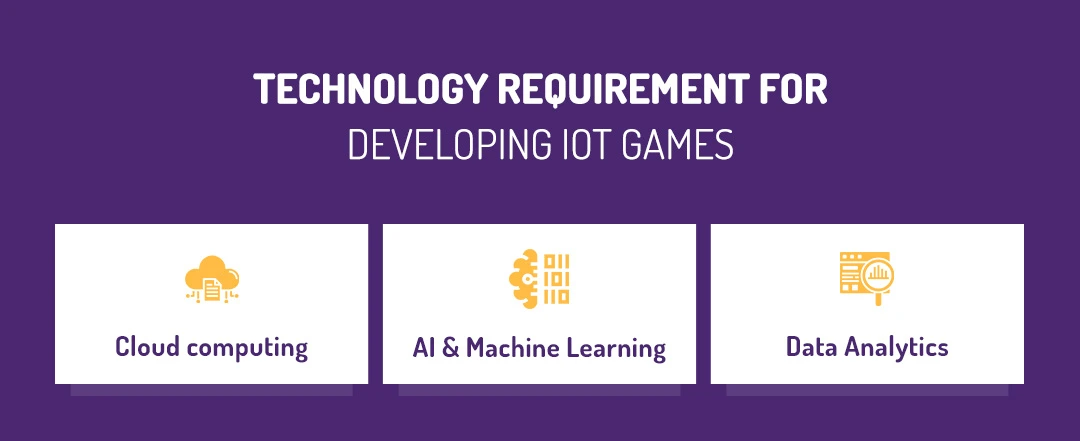
1. Cloud computing
Cloud computing is not limited to storage only, it has multi-dimensional use in the gaming industry. It’s an essential technology for developing IoT games as it allows developers to store and analyze large volumes of data in real time.
Moreover, it helps developers to develop games faster as they don’t need to worry about the storage and processing of data. They can also scale up their infrastructure quickly based on the gaming demands of users.
In addition, cloud-based virtual machines can also be used to run gaming applications with minimal latency. This will provide gamers with an uninterrupted gaming experience as the cloud will ensure that games don’t crash even when there is a huge surge in traffic.
2. AI and Machine Learning
AI and machine learning are the other two key technologies used for developing IoT games. Developers can use these technologies to create more realistic and intelligent gaming experiences.
For instance, with AI, developers can develop games that can adjust the difficulty level according to the skill level of players. This way, gamers will be able to play in a challenging yet enjoyable environment which will keep them engaged for longer periods of time.
In addition, machine learning can help developers to create games with better graphics and visuals, as this technology will enable them to create more realistic 3D models for their game environments.
Using machine learning, developers can gather data from gamers and use it to create better gaming experiences. This will also give developers an edge over their competitors as they can develop better and more innovative games.
3. Data Analytics
Data analytics is also an essential technology for developing IoT games. This technology helps developers to collect and analyze data from different sources, such as wearables, sensors, and gaming consoles.
By analyzing this data, game developers can identify which features are popular among gamers and use this information to develop better-targeted games. Moreover, using Big Data, developers can also collect data from different sources to gain valuable insights into how gamers interact with their games.
This will help them understand their user behavior and create more personalized gaming experiences for their players. For analyzing bigger data sets, developers will also need powerful computing resources. This is where cloud computing comes in handy as it provides the necessary infrastructure for such operations.
Hardware Requirements for IoT-based Gaming
Apart from the software requirements, developers also need to consider the hardware requirements for developing IoT-based games. These include devices such as wearables, sensors, and gaming consoles.
For instance, wearables are devices that can be used to track user movements, such as steps taken and other parameters. This data can be used to create an immersive gaming experience tailored to the user.
Similarly, sensors are devices that can track user movements and environmental conditions. This data can then be used to create more realistic gaming environments where the game itself is constantly changing based on the data collected.
In addition, gaming consoles are devices that can be used to create more interactive and engaging experiences. For instance, these consoles can be used to create virtual reality (VR) experiences that are more immersive than traditional gaming experiences.
Why Develop IoT-based Games in 2023 and Beyond?
As the world becomes increasingly connected, developers need to consider creating IoT-based games. In addition, smartphones are becoming more powerful and are now capable of running high-end games. This provides developers with an opportunity to create immersive gaming experiences that can be enjoyed by gamers anywhere, anytime.
Moreover, IoT-based games can also help developers to create more personalized experiences for their users. With the help of AI and machine learning, developers can create games that can adapt to each user’s preferences. This will enable them to provide an engaging gaming experience where gamers can play in environments that are tailored to their individual needs.
To get started, you need to partner with a professional and experienced IoT app development company like Auxano Global Services.
Wrapping up!
The Internet of Things (IoT) is transforming the way we play and interact with games. By leveraging data collected from IoT-enabled devices, developers can create more immersive and personalized experiences for gamers. As the popularity of IoT-based games continues to grow, developers need to partner with experienced IoT app development company to get started.
Frequently Asked Questions
-
1. What is the Internet of Things?
The Internet of Things (IoT) refers to a network of connected devices that are capable of communicating with each other and exchanging data. Moreover, these devices can be used to collect data that can be used to create personalized gaming experiences.
-
2. What are the benefits of developing an IoT-based game?
Developing an IoT-based game offers several advantages. These include providing gamers with a more immersive experience, creating personalized gaming experiences, and leveraging the power of AI and machine learning.
-
3. What technology advancements should developers consider for IoT-based games?
To create innovative and engaging IoT-based games, developers need to consider tech advancements like cloud computing, AI and machine learning, augmented reality (AR), and virtual reality (VR). Additionally, they should also explore the possibilities of leveraging IoT-enabled devices to create data-driven gaming experiences.
-
4. How much does it cost to develop an IoT-based game?
The cost of developing an IoT-based game depends on the complexity and scope of the project. To get an accurate estimate, you should consult with a professional and experienced game development company, as they can help you to create the perfect IoT-based game for your needs.
-
5. What types of games can I create with IoT?
You can create a variety of games using the power of the Internet of Things. From augmented reality (AR) and virtual reality (VR) games to turn-based and real-time strategy games, the possibilities are endless.



![How Much Does It Cost to Develop an IoT App? [2023]](https://www.auxanoglobalservices.com/agsresources/wp-content/uploads/2023/03/How-Much-Does-It-Cost-to-Develop-an-IoT-App.jpg)
